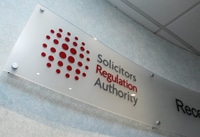A lack of transparency in complex business structures and ‘contagion’ from one part of a group to the law firm member are among the potential risks identified today by the Solicitors Regulation Authority (SRA) in its first-ever risk outlook.
A lack of due diligence in outsourcing arrangements and improper or abusive litigation are also on the regulator’s radar.
The outlook completes a trio of documents explaining the SRA’s new risk-based approach to regulation, following on from its regulatory risk framework and risk index.
The document considers the pressures bearing down on law firms – ranging from the weak economy and legal aid reform to consolidation and growing consumer use of the internet to find solicitors – before outlining the current, emerging and potential risks the SRA has identified.
Complexity and ‘group contagion’ are in the final category. The complexity of some businesses – both traditional law firms and alternative business structures (ABSs) – “creates the potential for serious problems such as financial difficulties or fraud to be ‘hidden’”, the SRA said.
“The structures of some legal services firms are very complex, and involve trusts, nominee or similar arrangements, shadow or de facto director arrangements or similar overseas interests, and complex ownership arrangements… Where complex structures are used, there must also be transparency between these businesses and their consumers, regulators and other third parties.”
The SRA said it does “not wish to restrict innovation or discourage complexity if it is beneficial to consumers and is appropriate for the firm”, but that such structures should not be deliberately opaque.
“Firms that apply for authorisation, whether as a recognised body or ABS, and are overly complex, with no sufficient reason why they are this complex, will at the very least be given close and continuous supervision, and may require restructuring before they are authorised.”
On ‘group contagion’, the SRA explained that the risk is that “liabilities, losses or events affecting one part of a group of firms affect a regulated legal firm within the group. Group contagion could place a law firm in financial difficulty even if it was effectively managing its own direct business activities.
“Group contagion might also be reputational, for example a scandal involving a firm in one part of the group could damage the brand of the whole group.”
Though it does not mention The Co-operative Legal Services, the well-publicised problems with The Co-operative’s banking arm is arguably one of the first examples of group contagion.
Completing the potential risks are improper or abusive litigation – involving either clients, such as the miners’ compensation scandal, or third parties, as in the file-sharing cases – and the lack of due diligence over outsourcing arrangements, where the failure to effectively manage can result in significant risks to consumers, in particular conflicts of interest, confidentiality and independence.
The current risks highlighted by the outlook are the high-profile issues with financial stability, as well as: the dishonest misuse of client money or assets; the lack of a diverse and representative profession; and the failure to co-operate and comply with regulation requirements, as shown by the large number of problems with the compliance officer nomination process.
Though as a whole the profession is very diverse, the SRA said progress to the higher ranks of law firms was the problem. “Barriers to progression reduce the likelihood of a strong, talented legal workforce able to provide services to a diverse population,” it said.
Emerging risks – that is, those where there is some evidence of a growing problem – are a lack of adequate succession or exit planning (the SRA said the recent intervention into Blakemores happened “because there was no viable exit strategy to respond to its severe financial difficulties”); poor standard of service or advice; and inadequate systems and controls over the transfer of money, because firms do not recognise the likelihood of being targeted by organised crime.
On service standards, the risk outlook said: “While levels of consumer satisfaction are relatively high, there is concern about the standards of service and quality of legal advice provided to consumers. In particular there is increasing evidence that the needs of a number of potentially vulnerable groups are not being met.”
SRA director of risk Andrew Garbutt told Legal Futures that the risk outlook demonstrated “that we’re maturing as a regulator”. He acknowledged that it will take time for the SRA to fully align its internal processes to the risk framework, “but by the end of the strategic plan in 2015, we should be there”.
He said: “The more we can put out there of our analysis and firms use it in their own risk assessments, the less likely it is that they will happen.”
The outlook will be presented to and discussed at an event hosted by the SRA tomorrow in Birmingham.
